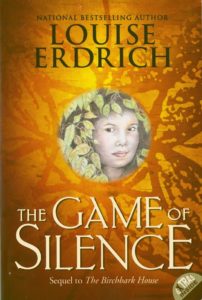Book review: The Game of Silence
 Reviewed by Karl Hele
Reviewed by Karl Hele
As the sequel to The Birchbark House, The Game of Silence continues the story of Omakayas and her family on Lake Superior. The book’s title references a game played among Anishinaabeg children, often at least in the novel, when adults were discussing important events and politics or conducting ceremonies.
The novel begins with a game of silence between Omakayas and her brother Pinch and ends with a game of silence as their people approach Bwaanag lands. Once again, Erdrich follows the family with the changing seasons through which she shares knowledge and stories of her family and people. For instance, we learn the importance of puff ball mushrooms in healing wounds.
The Game of Silence has a sense of foreboding within its covers. While hunger does not strike the community, a warming followed by a quick freeze almost claims several people, refugees from a Bwaanag attack arrive at the village, and people learn that the chimookoman are demanding that the Anishinaabeg move west. After people are sent out to discover why the Anishinaabeg have to move and what has caused these demands by the Americans, return famished and with dark news. A disastrous payment of annuities leaves hundreds of Anishinaabeg dead and Omakayas’ family wonders about the fate of loved ones. While this is ongoing, Omakayas learns more about her medicine gifts and fasts for the first time, with dreams showing her the general outline of her life including the departure from her home.
The second volume in the Birchbark house series is a good read. It offers a narrative of a family’s life intermixed with history and tradition. Although I found it less engaging than the first novel, I still enjoyed the story and eagerly await the third book in the series.
Overall, I would recommend the book to readers of all ages. Its utility in a classroom, however, would be muted unless the first volume is read as well.
Louise Erdrich, The Game of Silence. New York: HarperTrophy, 2005.


